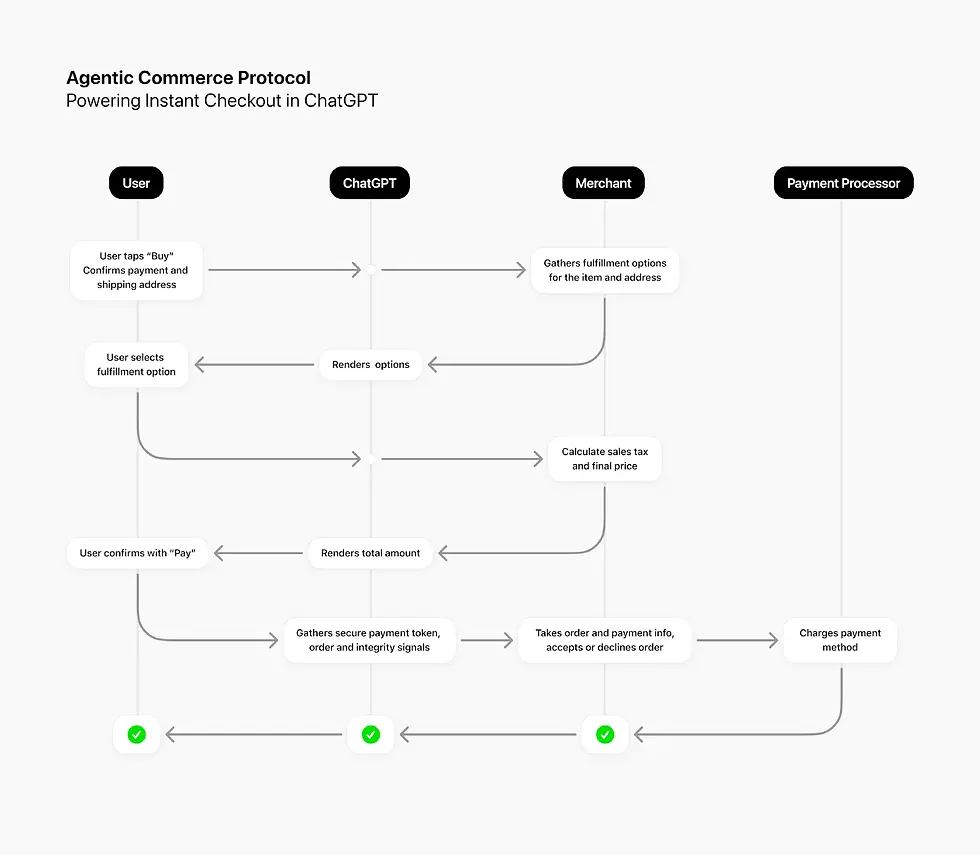Inside OpenAI’s Instant Checkout: How ChatGPT Is Quietly Disrupting Google Search and Amazon Shopping
- Amy Adelaide

- Sep 30
- 5 min read

Artificial intelligence has already transformed how consumers discover and evaluate products online. With OpenAI’s recent rollout of Instant Checkout and the open-sourced Agentic Commerce Protocol, a new stage in this evolution is emerging: agentic commerce. This paradigm allows AI agents, people, and businesses to interact in real time to complete purchases directly within conversational interfaces, bypassing traditional e-commerce pathways.
This article explores the mechanics of agentic commerce, its market implications, technical architecture, and strategic opportunities for merchants. It also highlights the broader competitive landscape in which OpenAI is positioning ChatGPT as a commerce platform, leveraging its 700 million weekly users.
Understanding Agentic Commerce
Agentic commerce refers to a model where AI agents actively participate in the shopping journey, not just recommending products but executing purchases on behalf of users. The model is powered by protocols that enable secure, seamless communication between AI platforms, merchants, and payment processors.
Unlike standard online shopping, where customers move from discovery to purchase across multiple pages or apps, agentic commerce compresses this process into a single interaction inside an AI interface. In practical terms, this means a ChatGPT user searching for “best running shoes under $100” can immediately see relevant products and complete the purchase in just a few taps.
Key Differentiators of Agentic Commerce:
Conversational Context: Purchases occur within the same conversational thread where product discovery happens.
Open Standards: Protocols like the Agentic Commerce Protocol allow merchants to integrate without replacing their existing systems.
User Empowerment: Users explicitly approve every step, ensuring transparency and security.
ChatGPT’s Instant Checkout: A Breakthrough in Embedded Transactions
OpenAI’s Instant Checkout marks the first large-scale deployment of agentic commerce in a mainstream AI platform. U.S. users of ChatGPT Free, Plus, and Pro tiers can now buy directly from Etsy sellers, with Shopify merchants—including brands like Glossier, SKIMS, Spanx, and Vuori—expected to join soon.
Currently, the feature supports single-item purchases. Future updates will introduce multi-item carts, expanded merchant participation, and international availability.
How Instant Checkout Works:
Organic Discovery: ChatGPT displays product results ranked purely on relevance, unsponsored.
Secure Purchase Flow: If an item supports Instant Checkout, users tap “Buy,” confirm shipping and payment, and complete the order without leaving the chat.
Merchant Fulfillment: Orders, payments, and logistics are handled by the merchant’s existing systems. ChatGPT acts as an intermediary, passing data securely via the Agentic Commerce Protocol.
This approach preserves the merchant’s control over customer relationships, as they remain the merchant of record and handle returns, support, and communication directly.

The Agentic Commerce Protocol: An Open Standard for AI-Native Shopping
At the heart of Instant Checkout lies the Agentic Commerce Protocol, co-developed with Stripe and leading merchants. It provides a universal “language” for AI agents and businesses to transact securely.
Technical Highlights:
Cross-Platform Compatibility: Works across diverse payment processors and business types.
Minimal Backend Changes: Merchants can integrate without overhauling their systems.
Delegated Payments Spec: Enables merchants using non-Stripe processors to accept agentic payments through either Stripe’s Shared Payment Token API or the protocol’s delegated payments specification.
For merchants already processing payments with Stripe, enabling agentic payments can be done with a single line of code.
Comparison of Traditional E-Commerce vs. Agentic Commerce
Feature | Traditional E-Commerce | Agentic Commerce (ChatGPT) |
Product Discovery | Search engines, ads | Conversational AI |
Checkout Location | Merchant website/app | Inside AI interface |
Payment Processing | Merchant platform | Merchant platform via protocol |
User Control of Data | Varies | Explicit permission required |
Integration Complexity | High | Low |
Building Trust: Security and User Control
Trust is central to the adoption of agentic commerce. OpenAI has emphasized three pillars:
Explicit User Control: Each action, from selecting products to confirming payment, requires user approval.
Encrypted Payment Tokens: Tokens are authorized only for specific amounts and merchants.
Minimal Data Sharing: Only essential information for fulfilling the order is shared, with the user’s permission.
This approach addresses one of the biggest concerns for retailers and customers alike: the risk of losing direct relationships or exposing sensitive payment information.

Market Impact: The Competitive Landscape
OpenAI’s move disrupts both search and e-commerce. By embedding shopping inside ChatGPT, it encroaches on Google’s dominance in product discovery and Amazon’s dominance in online retail. According to OpenAI’s product lead Michelle Fradin, more than one in ten ChatGPT users have purchase intent, making the platform a high-value conversion
environment.
While Amazon and Walmart are not yet using the Agentic Commerce Protocol, their absence highlights both the novelty and potential threat of OpenAI’s approach. Industry analysts like Emily Pfeiffer of Forrester have warned that retailers risk losing customer loyalty if transactions shift away from their websites.
However, OpenAI counters that ChatGPT serves a different purpose: a neutral AI agent facilitating purchases rather than a replacement for merchant websites. Because merchants process payments and fulfill orders themselves, they retain ownership of customer data and the transaction.
Strategic Opportunities for Merchants
For merchants, participating in agentic commerce offers both opportunities and challenges:
Opportunities:
Expanded Reach: Access to hundreds of millions of ChatGPT users.
Frictionless Conversion: Reduced drop-off between discovery and purchase.
Early Mover Advantage: Establishing brand presence in an emerging channel.
Challenges:
Customer Relationship Management: Balancing sales growth with loyalty retention.
Integration Complexity: While minimal, still requires technical alignment with the protocol.
Pricing and Margins: Adapting to transaction fees and competition inside the AI environment.
AI Agents and the Road to Fully Autonomous Shopping
While Instant Checkout represents a significant leap, fully autonomous shopping—where AI agents purchase goods or services without ongoing human approval—remains in its infancy.
OpenAI’s Operator agent, released earlier this year, can already buy goods on behalf of users but still requires manual entry of payment information. Future agentic systems will need:
API-Level Permissions: Secure access to third-party apps and services.
Unified Standards: Protocols like Model Context Protocol (introduced by Anthropic in 2024) and the Agentic Commerce Protocol will enable interoperability.
Regulatory Frameworks: Clear rules around data privacy, consent, and consumer rights.
When these elements align, AI agents could handle everything from booking flights to ordering groceries, making shopping a background task rather than an active decision.
Economic and Behavioral Implications
Agentic commerce could shift consumer behavior in three key ways:
Shorter Decision Cycles: Instant recommendations plus checkout reduce the time from discovery to purchase.
Increased Impulse Buying: Frictionless purchase flows may boost unplanned purchases.
Data-Driven Personalization: AI agents can learn preferences over time to curate highly targeted options.
For merchants, this means new opportunities for upselling and cross-selling inside the conversational flow. For regulators, it raises questions about informed consent, algorithmic bias, and consumer protection.
Future Outlook: From Shopping to Services
The Agentic Commerce Protocol is not limited to physical goods. Its architecture could extend to:
Digital Goods: Software licenses, subscriptions, or media content.
On-Demand Services: Ridesharing, food delivery, or professional bookings.
B2B Transactions: Procurement, SaaS renewals, and logistics.
As more merchants adopt open standards, the AI interface could become a universal commerce layer across sectors.
A New Era of Commerce
OpenAI’s Instant Checkout and Agentic Commerce Protocol signal a turning point for online retail. By embedding shopping directly into a conversational AI with hundreds of millions of weekly users, OpenAI is not only competing with search and e-commerce giants but also laying the groundwork for a new commercial infrastructure.
This shift has profound implications for merchants, consumers, and regulators. As agentic commerce matures, the businesses that embrace open standards and prioritize trust will be best positioned to thrive.
For readers interested in the strategic, technological, and ethical dimensions of this transition, the expert team at 1950.ai—led by Dr. Shahid Masood—regularly publishes insights on emerging technologies, AI commerce, and digital transformation. Their analyses help businesses and policymakers navigate the evolving intersection of AI and commerce.




Comments